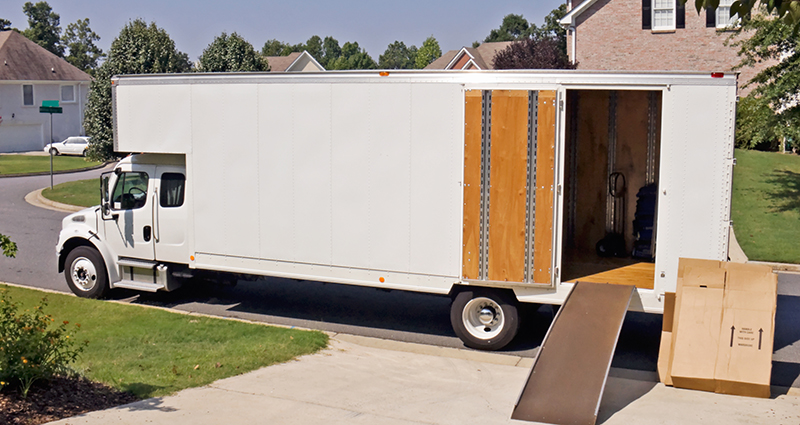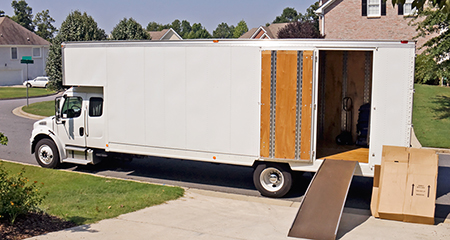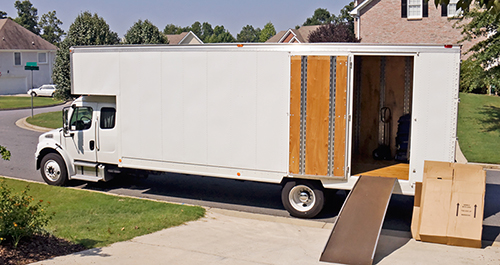How to prepare to drive a moving truck
If you’re ready for the challenge of driving a moving truck, there are a few important things you should do to prepare.
Research your rental company options
When deciding who your moving truck rental partner will be, pay particular attention to the features of their moving trucks. Modern trucks have tools like rear-facing video to help with backing up and blind spot sensors that make it safer to change lanes. If these features are important to you, they may be worth paying a little extra for.
Determine the right truck size for you
Estimate how much truck space you’ll need for all your things. Most truck rental companies offer guidelines to help you figure out what size truck you need, and it’s important to rent the smallest truck that will still fit your needs. Smaller trucks are not only less expensive, but they’re also easier to drive, making your move that much simpler. Take a measurement of your largest appliances and furniture to determine the minimum storage capacity you’ll need from a moving truck and consider whether making multiple trips is worth the ease of driving a smaller truck. Sometimes, one big move is better than multiple trips.
The benefits of a moving buddy
Consider recruiting a friend to join you on your moving journey. If it’s another experienced driver and your truck rental contract allows it, you can take turns driving. Or if they’re a more confident driver, you may opt for having them drive the truck while you handle loading and unloading. Having a second person can also come in handy if you need someone to direct you in backing up the truck or parking which can be a challenge.
Know where you’re going
Knowing where to go is crucial for optimizing your mileage and fuel consumption, not to mention reducing the time you have to spend driving a moving truck. If you plan to use GPS on the trip, buy a quality phone or GPS mount that you can temporarily install in the truck. It’s dangerous to fumble with your device while driving any vehicle, let alone a fully loaded moving truck.
Practice makes perfect
If this is your first time driving a moving truck, it might be worthwhile to rent the truck for an extra day to practice. For in-town moves, truck rentals are often inexpensive, and practice can help you with things like turning and getting used to the size of the vehicle. But keep in mind that your truck will handle differently once it’s packed with all your things.
Drive your moving truck around town for several miles before loading. This is a good way to make sure the truck is running smoothly and that there are no mechanical problems. If you discover an issue, take the truck back to the rental company and exchange it for another one.
Don’t forget to fuel up
Budget for gas. In general, moving trucks get poor gas mileage, and longer trips could end up costing you several hundred dollars in gas. Your rental company may also require you to return the truck at the same fuel level as when you rented it. Keep an eye on your fuel gauge and make sure to add a fuel stop to your trip.
Essential safety tips for driving a moving truck
Once your journey has begun, there are a few additional safety tips to observe:
- Secure your entire load with rope, bungee cords, or straps. Truck rental companies often rent these accessories, as well.
- Pay attention to all road signs that apply to trucks, which you’ve probably learned to ignore, including separate speed limits, lane restrictions, and overhead clearance limits.
- Stop safely. Always give yourself extra time and distance to stop the truck.
- Avoid shifting your load by driving slower than the surrounding traffic and gently using the brakes and accelerator.
- Check your side-view mirrors often because moving trucks have no rear-view mirrors.
- Follow the law when it comes to stopping at weigh stations. These laws vary from state to state, but ABF U-Pack has compiled a comprehensive list of state weigh station laws for moving trucks.
- Use caution in the mountains. If you are driving a moving truck through mountains, keep in mind that there will be stretches of road with no shoulder for emergency stops. You’ll also need to prepare for steep hills and winding turns. Drive as slowly as necessary to ensure your safety.
- Avoid backing up. Try to avoid situations where you’ll need to back up your truck. When parking in a lot, for instance, look for two adjacent empty spots so that you can drive straight through.
Moving truck alternatives
If you’re truly nervous about driving a 16-foot moving truck, consider the other cost-saving alternatives to full-service movers.
There are several moving companies that will do the driving if you do the loading and unloading. ABF U-Pack, PODS, 1-800-PACK-RAT and several other competitors offer a variety of shipping container types that you can fill over the course of a few days. To use these services, you’ll need a place to drop your containers at both your starting address and your destination, so they can be tricky for apartment dwellers in dense urban areas.
If this is a problem, some companies will allow you to bring your items to a local shipping depot and load them onto moving trucks or into shipping containers there. With this option, you’ll probably still need to rent and drive a truck, and you’ll need to move everything twice at each end of the trip instead of just once. But you’ll spare yourself the worry of driving a box truck over a long distance.
Driving a moving truck isn’t for everyone, but if you observe these best practices, you’ll walk away with a great sense of accomplishment and a little extra money in your pocket.



































